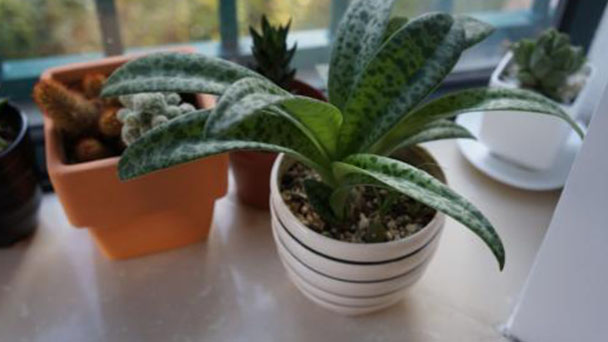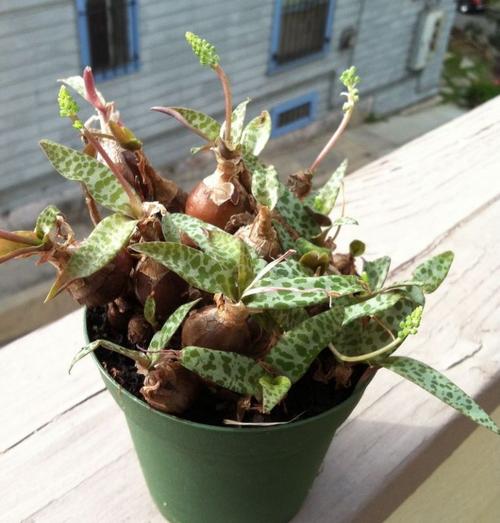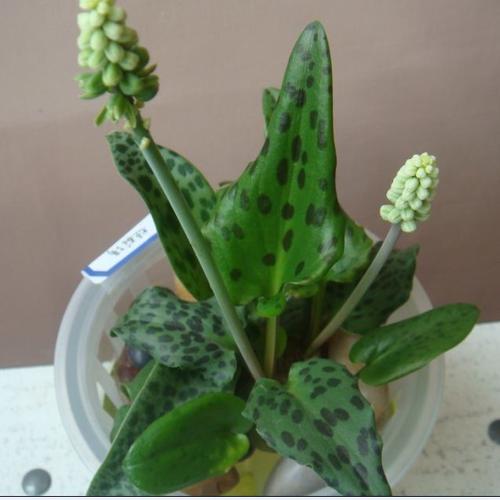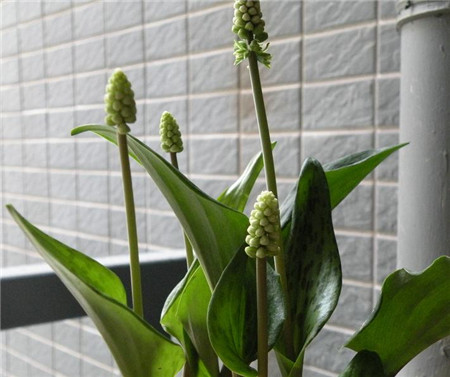Giant squill (Drimiopsis kirkii) profile
Written by Maggie
Aug 31 2021

Giant squill (Drimiopsis kirkii) is a succulent perennial herbaceous plant of the Liliaceae, native to South Africa. Giant squill is about 10 -- 15 cm high, the purplish red stem is hypertrophic and bottle shaped, the stem is topped with 3 -- 5 fleshy leaves, the leaves are silvery green with irregular spots, and the back of the leaves is purplish red. Flowering in spring and summer, panicles, florets green, about 0.3 cm, 6 petals, bell-shaped aggregation at the base, stamens purplish red.
The giant squill leaves are dark green with raindrop markings. The rhizome is spherical, fat short, slightly red, at first glance a little like onion, very lovely.
Giant squill picture

Morphological characteristics of giant squill
Giant squill is about 10-15 cm in height. The stem of the Giant squill is hypertrophic and bottle shaped, with 3-5 fleshy leaves at the top. The leaves are silvery green with irregular spots, and the back of the leaves is purplish red. Panicles, small green flowers, ca. 0.3 cm, 6 petals, bell-shaped base aggregates, stamens purplish red, Giant squill.
Leaf
Giant squill height is about 5~30 cm, lanceolate, fleshy, apex acute, gray-green leaves, and spread thick green oily spots.
Flowers
Giant squill (Drimiopsis kirkii) has slender pedicles and dozens of small white flowers at the top.
Ecological habits of the giant squill
Giant squill receives adequate illumination. The more adequate illumination, the shorter and fatter the plant will be. If insufficient illumination, the whole plant will be elongated and lose its ornamental value. It is recommended to observe the new leaves when planting. If the new leaves are larger and lighter than the old ones, the light is insufficient, and it should be moved to a place with more sufficient light.
Giant squill prefers light. Under sufficient light conditions, its leaves are dark green with obvious markings. Although the Giant squill can grow under normal scattered light, the leaves become narrow and long, with pale green leaves and dull markings. Prolonged lack of light can also cause plants to fall over and their leaves to fall off. Summer high temperature season should pay attention to sun protection, and can not let the sun exposure, otherwise the herb leaves are easy to be scorched, affecting the ornamental value.
How to grow and care for giant squill
Light
Giant squill (Drimiopsis kirkii) prefers light. Under sufficient light conditions, its leaves are dark green with obvious markings. Although the plant can grow under normal scattered light, the leaves become narrow and long, with pale green leaves and dull markings. Prolonged lack of light can also cause plants to fall over and their leaves to fall off. Summer high temperature season should pay attention to sun protection, and can not let the sun exposure, otherwise the herb leaves are easy to be scorched, affecting the ornamental value.
Water
Giant squill does not have high requirements on fertilizer and water. If sufficient base fertilizer can be added in the repot, the squill can grow well without additional fertilization. Giant squill is the root of the corm, so water should not be too much in the curing process, and water in the basin should be avoided. Basin soil to "see dry see wet", two days of water in summer, other seasons to see the dry wet basin soil to decide whether to water. You can also use the method of observing the leaves to judge, if the leaves are not as erect as before, look a little low, and the color of the leaves is darker, it means that the need for watering.
Potted flower management
Giant squill (Drimiopsis kirkii) grows rapidly. If it is carefully nurtured, the root of the bulb will overgrow the flowerpot after one year. The overcrowded bulb roots will affect the growth of the plant. Remove some of the unwanted bulbs to give the plant a better supply of nutrients. The removed seedlings can be reproduced to form a new Giant squill.

How the Giant Squill propagates
Giant squill propagation can be carried out by splitting and sowing methods, and splitting is usually the most common method for reproduction.
All seasons except winter are suitable. Just disassemble the Giant squill from the bulbs, remove the old and dead leaves, and plant them separately. If you want to sow, you can help pollinate with a brush when the flower is blooming. After the seed is mature, you can pick the seed and sow it on the medium with good drainage. After the seedling sprouts, you will grow the fat stem, which is very lovely. Giant Squill does not require much fertilizer, so it can apply some Hercondo 1 to the surface of the pot in spring and summer.
Propagation of the Giant Squill is simple and can take place at any time of the year. The specific method is: the need to transplant the corm root with leaves from the overall soil dug out, remove the old leaves, planted in the new soil prepared, and then pour enough fixed root water, put in the ventilation shading, a few days later will survive. We need to pay attention to: to the new pot of soil planted, must be exposed a little bulb root, can not be completely buried, otherwise it is difficult to survive.
The distribution area of the giant squill
Giant squill (Drimiopsis kirkii) is native to South Africa.
The purpose of the giant squill
Beautify the watch
With dark green leaves and raindrop markings, the Giant Squill is ideal for landscaping or potting in shaded areas.
Potted value
Giant Squill is a common small pot plant. It is sold as a 3-inch pot plant in the market. In fact, Giant Squill is also a member of succulent plants.

Latest Updated
- Benefits of Bugleweed - 7 Science-backed Health Benefits
- Bugleweed Dangers & Side Effects - Is It Poisonous?
- How to Plant Evergreen Trees - What You Should Know
- When to Plant Evergreens - Grow Guide for Evergreen Trees
- 12 Wonderful Evergreen Shrubs for Your Garden
- 12 Popular Evergreen Plants with Pictures for Beginners
- When And How To Prune A Lilac Bush Like a Pro
- How to Grow & Care for Lilac Vine (Hardenbergia Violacea)
- Japanese Lilac Tree (Syringa Reticulata) Care & Propagation Guide
- Shumard Oak Pros and Cons - What to Know
Popular Articles
- Winter maintenance of Antirrhinum Majus
- How to Grow Terminalia Mantaly Tree
- How to Grow and Care for Crossostephium Chinense
- How to grow Antirrhinum Majus in spring
- Peristeria Elata (Dove Orchid) Profile: Info & Care Guide
- Underwatered Snake Plant (Sansevieria Trifasciata) - Signs And How To Fix
- How to Care for Brazilian Jasmine Plant (Mandevilla Sanderi)
- How to Grow & Care for Graptopetalum Purple Delight in Summer
- Rosa Chinensis (China Rose): Plant Growing & Care Tips
- How to Care for Baby Sun Rose (Aptenia Cordifolia)